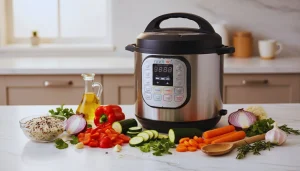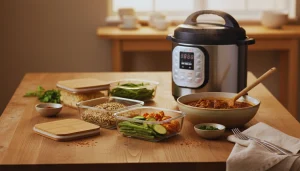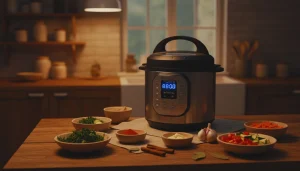Using a modern multi-cooker can feel intimidating at first—especially when you’re faced with a device that claims to sauté, steam, slow cook, pressure cook, and even make yogurt all in one. With so many buttons, settings, and features, it’s easy to wonder if it’s really worth the effort to learn. But once you understand how it works, the Instant Pot (or any multi-cooker) can completely transform the way you cook.
In this post, I’ll walk you through everything you need to know—from choosing the right model for your cooking style and family size to mastering daily use, proper cleaning, and simple maintenance tips to keep it running for years. I’ll also share some of my favorite accessories that make cooking even more convenient and enjoyable. Whether you’re a beginner who’s never touched a pressure cooker before or someone looking to level up your kitchen game, this guide will help you go from “never used it” to “Instant Pot pro” in no time.
Here’s what you’ll learn:
- What is an Instant Pot (and why it’s worth it)
- Buying guide: what to look for
- Brand comparisons & model reviews
- How to use it (step by step)
- How to clean & care
- Best accessories & maintenance tips
- FAQ—quick answers
Let’s dive in.
What Is an Instant Pot & Why Use One?
I see many home cooks treating an Instant Pot like a black box. It’s not magic—it’s a smart, electric multi-cooker that combines pressure cooking, slow cooking, sauté, steaming, yogurt making, and more. With one machine, you can speed up tasks that used to take hours.

Benefits over traditional cooking:
- Faster cook times (e.g., tough cuts of meat, beans)
- One-pot convenience (less cleanup)
- Precise controls reduce guesswork
- Programmable settings let you set and forget
- Safer than stovetop pressure cookers (many safety features)
As a busy professional, I understand that time is money. The Instant Pot saves both.
Buying Guide: What You Actually Need

Before purchasing, evaluate your priorities. Not all features matter equally. Here’s my framework:
A. Capacity / Size
- 3 qt: good for two or small side dishes
- 6 qt: the sweet spot—fits families of 3–5
- 8–10 qt: for batch cooking, large family, entertaining
If you’re unsure, get 6 qt. Most recipes online assume it.
B. Cooking Functions vs Essentials
Decide what you will actually use. Do you care about yogurt, sous vide, or air frying? If not, a simpler model saves cost and complexity.
C. Controls & Usability
Look for easy sealing/venting knobs. A quick-release steam handle is less stressful. Clear, intuitive buttons matter.
D. Inner Pot Material
Stainless steel is robust and safe. Some models offer nonstick or ceramic coatings—useful for rice or delicate foods.
E. Safety & Certifications
Check for overpressure release mechanisms, certified lids, and safety locks.
F. After-sales / Warranty / Parts Availability
You’ll want spare sealing rings or replacement lids. Select brands or models that offer reliable support in your region.
Brand Comparisons & Top Models
When I compare brands, I focus on value, support, reliability, and smart features (not just glitzy extras).

-
Instant Pot (the brand)
Instant Pot dominates the market, with many models. Among them:
- Instant Pot Duo (7-in-1)—the reliable all-around model and my go-to pick for most users.
- Duo Evo Plus—a refined version with faster pressure release and an improved interface.
- Instant Pot Pro—highlighted by Food & Wine as best overall for balancing feature set and performance.
- Instant Pot Rio—praised by Bon Appétit as the “simplest to use” entry-level. Bon appétit.
- Duo Crisp / Air Fryer combos—dual function, but critics warn about compromised performance in both modes.
Why I often recommend the Duo (6 qt 7-in-1): It handles nearly every everyday task and offers a great price for performance.
-
Other Brands (brief note)
While many generic pressure cookers exist, they often lack consistent firmware updates, spare parts, or community support. For serious users, the known brand (Instant Pot) tends to be less risky.
How to Use an Instant Pot (Step-by-Step)
Here I’ll show you exactly how I use mine (and you can too).
a) Setup & First Use
- Wash the inner pot, lid, and sealing ring.
- Place the inner pot inside the cooker base.
- Ensure the sealing ring is seated correctly in the lid.
- Add your ingredients plus the required liquid (don’t skip liquid—pressure cooking needs steam).
- Close the lid; align and lock.
- Set the vent from “Venting” to “Sealing.”
- Choose your cooking program (Pressure Cook, Manual, Rice, etc.).
- Adjust time/pressure if needed.
- When done, either use Natural Release (wait until pressure drops naturally) or Quick Release (turn the vent).
- Open the lid away from the face (avoiding steam).

b) Example – Cooking Chicken & Rice
- Sauté onions, garlic using the sauté mode
- Add rice + broth + desired seasonings
- Place the chicken on top
Close lid, seal, select “Pressure Cook” on high for 8–10 minutes - Natural release 10 minutes, then quick release
- Check internal temperature, fluff rice
c) Switches (e.g., Yogurt, Slow Cook)
- Many models include a Yogurt button. After cooking, allow to cool and incubate according to the recipe.
- Use “Slow Cook” mode when you want gentle simmering—great for overnight stews.
- Steam or sauté modes let you lightly cook vegetables or brown meat.
d) Tips to Avoid Errors
- Don’t overfill—leave ⅓ headspace for steam.
- Use non-foam liquids (water, broth) for pressure.
- Deglaze after sautéing to avoid burn errors.
- Switch sealing rings if switching from savory to sweet to avoid flavor carryover.
How to Clean & Care (Maintenance Guide)
I use these steps after nearly every cook. It keeps performance sharp and parts lasting.

A. Daily Cleaning
- Remove the inner pot and wash it with dish soap (some are dishwasher safe).
- Wash lid parts (ring, float valve, anti-block shield). Use a small brush to clear the steam valve.
- Wipe the base exterior (unplug first). Never submerge the base.
- Dry all parts thoroughly before reassembling.
B. Monthly / Deep Maintenance
- Inspect the sealing ring: if it’s cracked, misshapen, or smells strongly, replace it.
- Clean the rim, the gasket groove, and the underside of the lid.
- Check the steam release mechanism; clear any residue.
- If the model supports it, run a water test (just water inside) to check for leaks.
C. Replacing Parts
Sealing rings and inner pots degrade over time. Always have a spare ring. Use manufacturer-approved parts to maintain safety and warranty.
Accessories & Tips I Swear By
Accessories can push your Instant Pot from good to game-changing. But you don’t need every gimmick. I focus on what truly adds value.
Must-Have Accessories
| Accessory | Why It’s Worth It | Notes / Source |
| Extra sealing rings (sweet/savory) | Prevents flavor crossover and gives spares | Kitchen Stewardship highlights this necessity |
| Stackable steamer pans | Enables multi-level cooking (e.g., meat and veggies) | Eat at Home calls this a top accessory |
| Tempered glass lid | Let’s you see food when using slow cook/sauté | Many users prefer this for transparency |
| Silicone egg racks | Perfect for one-step hard-boiled eggs | Also avoids eggs touching pot bottom |
| Extra inner pot (nonstick or alternate material) | Switch between recipes without cleaning mid-cook | Bon Appétit notes nonstick pots’ usefulness Bon Appétit |
| Carry case | Useful for travel or potlucks | Especially helpful if you transport your unit |
Note: Avoid buying every novelty. Focus on those that match your cooking style.
Final Thoughts & Call to Action
I believe the Instant Pot is one of the most practical tools any modern kitchen should own—if you learn to use it well. You don’t need the priciest model. Start with the 6 qt Duo or Pro, pair it with a spare sealing ring, and master the basics.

- Want my recommended model list and direct links? Check the latest price on Amazon
- Looking for Instant Pot recipes like biryani, soups, or desserts? Explore my blog’s recipe archive
- Want a printable cheat sheet of cooking times? Drop me a message, and I’ll send you one free
Give it a try tonight—pressure cook something simple like rice and veggies or chicken. After your first successful meal, you’ll see how the Instant Pot can transform weeknight cooking.
FAQ (Frequently Asked Questions)
Q: Is it safe to leave food inside overnight under “Keep Warm”?
A: Yes, for many recipes, 12–24 hours is fine. But long holds may degrade texture. Always exercise judgment.
Q: Can I use the Instant Pot as a rice cooker only?
A: Absolutely. Many models include a “Rice” or “Grain” mode. Just follow the ratio and ensure some liquid.
Q: Why did I get a “Burn” error?
A: Usually, because food is stuck to the bottom, there is not enough liquid, or the sealing ring is loose. Deglaze and check your ring.
Q: How often should I replace the sealing ring?
A: Every 12–18 months or whenever it shows wear, odor, or warping.
Q: Can I pressure can in the Instant Pot?
A: No—most models are not designed for safe home canning. Only very few high-pressure specialized models support it.
Q: Which setting should I use—high or low pressure?
A: Use high for dense ingredients (beans, meats) and low for delicate foods (custard, fish).